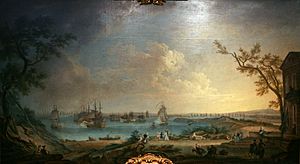Battle of Minorca (1756) facts for kids
Quick facts for kids Battle of Minorca |
|||||||
|---|---|---|---|---|---|---|---|
| Part of the Seven Years' War | |||||||
 The departure of the French squadron on 10 April 1756 for the attack against Port Mahon, by Nicolas Ozanne |
|||||||
|
|||||||
| Belligerents | |||||||
| Commanders and leaders | |||||||
| Marquis de la Galissonnière | John Byng | ||||||
| Strength | |||||||
| 12 ships of the line 5 frigates |
12 ships of the line 7 frigates |
||||||
| Casualties and losses | |||||||
| 38 killed 184 wounded |
Half the fleet damaged 45 killed 162 wounded |
||||||
The Battle of Minorca was a big naval fight between the French and British navies. It happened on May 20, 1756, near the island of Minorca in the Mediterranean Sea. This battle was the first major sea clash of the Seven Years' War in Europe. The French fleet won the battle. After the fight, the British decided to leave Minorca and sail to Gibraltar. This choice gave France a big advantage and led to them taking over Minorca.
The British failure to protect Minorca caused a lot of trouble for their commander, Admiral John Byng. He was put on trial for not doing his best to help the British soldiers on Minorca. He was found guilty and faced a very serious punishment.
Contents
Why the Battle Happened
Minorca was an island controlled by the British since 1708. The French wanted to take it back. The Seven Years' War had already started in America in 1754. At first, things were not going well for Great Britain. The British government was worried about protecting their lands closer to home. They even feared that France might try to invade Great Britain itself.
France finally made a move on Minorca. The British government sent a fleet of 10 warships to defend the island. Vice-Admiral John Byng was put in charge. Even though the British knew how strong the French fleet was at Toulon, Byng's ships were old and didn't have enough sailors.
Getting Ready for Battle
When Admiral Byng and his fleet arrived near Minorca on May 19, they found that French troops had already taken over most of the island. Only the British soldiers in St. Philip's Castle in Port Mahon were still fighting. Byng's orders were to help these soldiers.
However, a French fleet of 12 warships and 5 smaller ships appeared. The two fleets spent the afternoon getting into position. The big battle was set for the next morning.
The Battle Begins
Admiral Byng had 12 of his largest ships face the 12 French warships. He lined up his ships and sailed towards the French fleet. He wanted his ships to get close to the French ships and fire their cannons.
But, the way signals were given back then was not very good. This caused confusion and delays for the British ships. The front part of the British line took a lot of damage from the French ships. However, the ships at the back, including Byng's own ship, did not get close enough to fire effectively.
During the battle, Byng was very careful and stuck to old fighting rules. Several of his ships were badly damaged. The French, however, did not lose any ships. After the battle, Byng held a meeting with his senior officers. They all agreed that the fleet could not damage the French ships further or help the soldiers on Minorca. So, Byng ordered his fleet to return to Gibraltar.
What Happened Next
The battle was clearly a French victory. Byng did not continue fighting to help the soldiers or chase the French fleet. This lack of action led to a lot of criticism. The British navy leaders, perhaps trying to hide their own mistakes, blamed Byng.
He was put on trial for not doing everything he could to follow his orders and support the soldiers. He was found guilty and sentenced to death. Even though many people asked for him to be spared, he was executed on March 14, 1757. This happened on his ship, HMS Monarch, in Portsmouth harbour.
The writer Voltaire mentioned Byng's execution in his famous book Candide. He wrote, "In this country, it is thought wise to kill an admiral from time to time to encourage the others." This famous line suggests that Byng's death was meant to make other admirals try harder.
Even though William Pitt wanted to get Minorca back, the British did not send another group of ships to recapture it during the war. Minorca was finally given back to Britain after the Treaty of Paris in 1763. In return, France got back some islands in the West Indies and Belle-Île.
Images for kids
See also
 In Spanish: Batalla de Menorca (1756) para niños
In Spanish: Batalla de Menorca (1756) para niños
- HMS Dolphin
- Arthur Phillip, an otherwise notable midshipman



